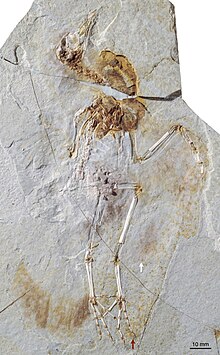Hongshanornis
| Hongshanornis | |
|---|---|

| |
| Fossil specimen | |
| Scientific classification | |
| Domain: | Eukaryota |
| Kingdom: | Animalia |
| Phylum: | Chordata |
| Clade: | Dinosauria |
| Clade: | Saurischia |
| Clade: | Theropoda |
| Clade: | Avialae |
| Clade: | Ornithuromorpha |
| Family: | †Hongshanornithidae |
| Genus: | †Hongshanornis Zhou & Zhang, 2005 |
| Species: | †H. longicresta
|
| Binomial name | |
| †Hongshanornis longicresta Zhou & Zhang, 2005
| |
Hongshanornis is a
Hongshanornis is a member of the group Hongshanornithidae, to which it lent its name. It is closely related to Longicrusavis, which existed alongside Hongshanornis in the Dawangzhangzi ecosystem, and is very similar to the later Parahongshanornis from the Jiufotang Formation.[2]
Description
Hongshanornis longicresta was a small species, especially compared to other early ornithuromorphs (birds with a modern tail anatomy), about the size of a

The skull in all known specimens is poorly preserved, but in general appears to have had a narrow snout compared to the closely related
The original describers of Hongshanornis noted the apparent presence of a large feathered crest on the head,[4] though the feather traces are extremely poor quality and it may be an artifact of preservation.[3] A second specimen from different fossil beds did not have long feathers on the head, but rather showed feathers which became shorter closer to the snout.[2]
The wings were long and broad, but tapered and pointed at the tips. The first few primary flight feathers were much shorter than the rest. The total wing area was 0.016 square meters. The wing digits bore small claws, with the claw on the first finger (the alular digit) much larger than that of the second finger (major digit).[2] Hongshanornis is characterized by very long legs, with the lower leg (tibiotarsus) more than one and a half times longer than the upper leg (femur). The toes were long and thin, with small claws. The first toe (hallux) was very small, and the second toe was much shorter than the fourth. The third toe was longest.[2]

The bones of the tail have not been preserved in any known specimen, but comparison with related species suggest it was short with a small, plowshare-shaped pygostyle bone, to which the tail feathers anchored. A mass of muscles, called the rectorial bulb, probably was present to control the fanning of the trail feathers. The tail feathers were long, with symmetrical vanes. There were at least 10 tail feathers (rectrices), more than in other primitive fan-tailed birds. The overall shape of the tail was rounded and wedge-shaped when viewed from above; due to the symmetrical feathers, the sides of the tail were probably not held fully fanned into the wind but swept back, forming a partially fanned wedge, as in some modern birds like accipiters, tyrant flycatchers and sunbitterns.[2]
Biology
Diet and ecology

Due to the assumption of toothlessness, hongshanornithids were originally interpreted as having a very specialized diet and ecology, perhaps as waders or shorebirds due to their slim snouts and long legs. However, the confirmation that they did in fact have teeth in both jaws has led to a re-interpretation of their ecological niche. Though still considered probably wading birds, they probably had a more generalized diet than previously assumed, with the different snout shapes present in different members of the group indicating niche portioning within a general wading ecology (Hongshanornis lived alongside the closely related Longicrusavis, and both were very similar to each other except for the shape of the snout).[2] One specimen of Hongshanornis preserved several gizzard stones (gastroliths) of various sizes, which is usually an indication of an herbivorous diet.[2] Another specimen originally assigned to the genus Hongshanornis preserved fossilized seeds in the crop;[5][2] however, this specimen was subsequently transferred to a distinct taxon Eogranivora edentulata.[6]
Flight

The wings of H. longicresta were broad and tapered, with an average wing area and wing loading compared to modern birds in the same size range.[2] The presence or absence of slotting at the wing tips cannot be determined with known specimens, but modern birds with similar size and wing shape tend to lack wing slotting. The absence of wing slotting would suggest that Hongshanornis tended to fly mainly at relatively high speeds. Given the overall wing shape and comparison to modern birds, Hongshanornis probably flapped continuously when flying at lower speeds, and switched to bounding flight (rapid flapping alternating with periods of ballistic forward motion with the wings partly folded) at higher speeds. Overall, the wing and tail anatomy, and therefore probably flight style, of Hongshanornis was similar to many medium-sized passerine birds.[2]
References
- ^ doi:10.1002/gj.1045.
- ^ PMID 24482756.
- ^ S2CID 53489175.
- ^
- PMID 21896733.
- PMID 29386367.
